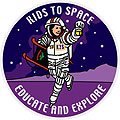14. What if we use nuclear rockets to get to the Moon? (A K2S Question)
From The Space Library
When we get to using nuclear rockets in space, we'll be able to get to the Moon in a few hours, or Mars in a few weeks. This will be done by constantly speeding up until we are halfway there, turning off the engines and flipping over, and then using the rocket thrust to slow down. This can be imagined as riding in a car. When the car accelerates quickly, one feels pushed back into the seat (although really the seat is pushing into you trying to overcome your inertia). With a lot of technology we can make the nuclear rocket accelerate such that the floor will be pushing against you as if you were in the equivalent of the Earth's gravity at its surface, or 1g. This means a lot of acceleration, which means very high speeds are reached, much higher than the 17,500 miles per hour (mph) relative speed of the Space Shuttle. After the midway point the rocket is facing the other way and thrusting to decelerate back down to orbital speed for the Moon or Mars. Since the rocket is flipped around, the floor is still the floor and the occupants will still feel 1g—except during the quick 180 degree flip in the middle of the trip when occupants will be weightless while the spacecraft turns around. Using the car example, it can be thought of as the push against the safety belts when the car brakes quickly.
Answer provided by Thomas Matula, Ph.D. & Kenneth J. Murphy
 Question and Answer extracted from the book Kids to Space - by Lonnie Schorer
Question and Answer extracted from the book Kids to Space - by Lonnie Schorer
Buy This Book Click here |

